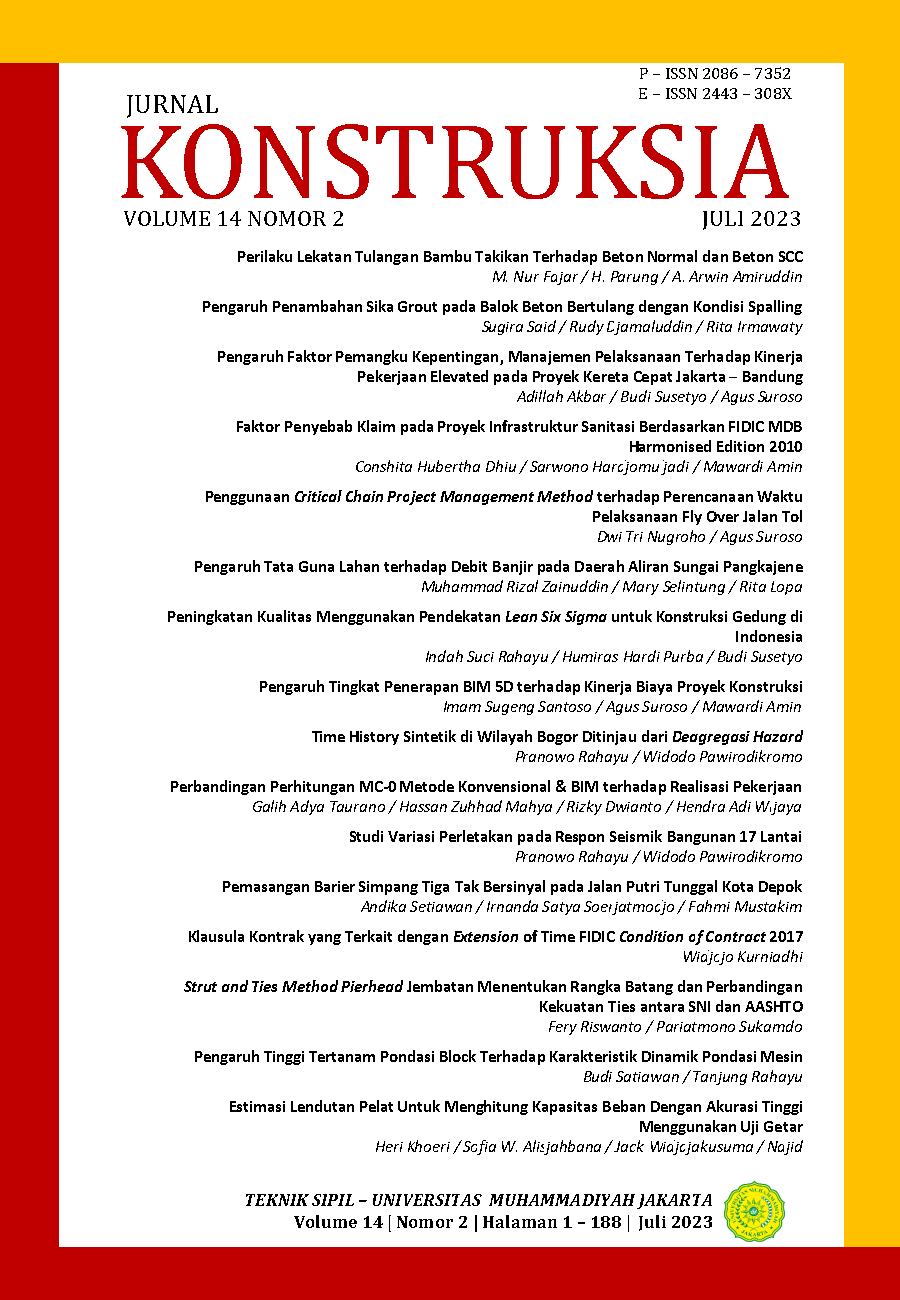Peningkatan Kualitas Menggunakan Pendekatan Lean Six Sigma Untuk Konstruksi Gedung Di Indonesia
DOI:
https://doi.org/10.24853/jk.14.2.73-82Keywords:
Konstruksi, Lean Six Sigma, Structural Equation Modeling-Partial Least Square (SEM-PLS), Pekerjaan SuperstrukturAbstract
Indonesia melalui kota Jakarta sedang gencar dibangun. Berdasarkan survei konsultan konstruksi, pembangunan merupakan langkah terbaik untuk memenuhi kualitas hidup masyarakat luas. Kinerja pembangunan harus meningkatkan kualitas baik sarana maupun prasarana. Tujuan dari penelitian ini adalah untuk menganalisis faktor dan pengaruh evaluasi metode lean six sigma pada pekerjaan gedung perkantoran. Diperlukan metode lean six sigma yang digunakan untuk menganalisis fungsi-fungsi yang dibutuhkan dengan kinerja yang berkualitas untuk pekerjaan gedung perkantoran. Metode Structural Equation Modeling-Partial Least Square (SEM-PLS) dianalisis menggunakan software SmartPls untuk menganalisis faktor-faktor yang mempengaruhi kualitas dan waktu. Hasil dari penelitian ini adalah faktor-faktor yang terjadi pada pekerjaan suprastruktur, material, tenaga kerja, dan manajemen proyek: Y1 =0,529X1 + 0,073X2 - 0,231X3 + 0,072X4 + 0,017X5 - 0,036X6 + 0,125X7 danY2= -0,038X1 + 0,001X2 - 0,199X3 - 0,024X4 + 0,390X5 + 0,357X6 - 0,108X7. Penilaian penerapan Lean Six Sigma dari nilai Non-Conformance Report (NCR) sebesar 181, data sigma untuk cacat yang dihasilkan oleh pekerjaan suprastruktur dengan nilai DPMO sebesar 6.725,624 atau setara dengan 3,99 sigma.References
Supriyatna, H., Kurniawan, W., & Purba, H. H. (2020). Occupational safety and health risk in building construction projects: A literature review. Operational Research in Engineering Sciences: Theory and Applications, 3(1), 28–40. https://doi.org/10.31181/oresta200134s
Lakhiar, M. T., Lakhiar, M. T., & Halid, A. (2021). High-Rise Building Projects in Pakistan : a Systematic Literature Review. Operational Research in Engineering Sciences: Theory and Applications, 4(1), 99–114. https://doi.org/10.31181/oresta2040199l
Zaira, M. M., & Hadikusumo, B. H. W. (2017). Structural equation model of integrated safety intervention practices affecting the safety behaviour of workers in the construction industry. Safety Science, 98, 124–135. https://doi.org/10.1016/j.ssci.2017.06.007
Osmanovic, N., & Alvi, S. (2022). A Determinants of FDI in the Economy of GCC Countries: A PMG ARDL Approach. Operational Research in Engineering Sciences: Theory and Applications, 5(3), 1–16. https://doi.org/10.31181/oresta031022046o
Setiawan, Setiawan, I., Jaqin, C., Prabowo, H. A., & Purba, H. H. (2021). Integration of Waste Assessment Model and Lean Automation to Improve Process Cycle Efficiency in the Automotive Industry. Quality Innovation Prosperity, 25(3), 48–64. https://doi.org/10.12776/qip.v25i3.1613
Ediati, R., Ulfa, M., Fansuri, H., Ramli, Z., Nur, H., & Prasetyoko, D. (2014). Influence of TiO2/TS-1 calcination on hydroxylation of phenol. Journal of Mathematical and Fundamental Sciences, 46(1), 76–90. https://doi.org/10.5614/j.math.fund.sci.2014.46.1.7
Tampubolon, S., & Purba, H. H. (2021). Lean six sigma implementation, a systematic literature review. International Journal of Production Management and Engineering, 9(2), 125–139. https://doi.org/10.4995/IJPME.2021.14561
Kumar, N., Jarial, S. K., & Narwal, M. S. (2019). Lean Six Sigma in Brazil: a literature review. International Journal of Lean Six Sigma, 10(1), 435–472. https://doi.org/10.1108/IJLSS-09-2017-0103
Durdyev, S., Ihtiyar, A., Banaitis, A., & Thurnell, D. (2018). The construction client satisfaction model: a PLS-SEM approach. Journal of Civil Engineering and Management, 24(1), 31–42. https://doi.org/10.3846/jcem.2018.297
Siregar, K., Ariani, F., Ginting, E., & P, T. D. M. (2019). Lean six sigma for manufacturing industry : a review Lean six sigma for manufacturing industry : a review. IOP Conference Series: Materials Science and Engineering. https://doi.org/10.1088/1757-899X/505/1/012056
Asih, I., Setiawan, I., Hernadewita, H., & Hendra, H. (2022). Effects of ergonomics intervention on work accidents in the construction sector and their effect on productivity. Jurnal Sistem Dan Manajemen Industr, 6(1), 45–55. https://doi.org/http://dx.doi.org/10.30656/jsmi.v6i1.4242
Buniya, M. K., Othman, I., Sunindijo, R. Y., Kineber, A. F., Mussi, E., & Ahmad, H. (2020). Barriers to safety program implementation in the construction industry. Ain Shams Engineering Journal, 12(1), 65–72. https://doi.org/10.1016/j.asej.2020.08.002
Putri, L. E., Rimawan, E., & Setyadi, A. (2021). The Relationship of Job Satisfaction, Flexible Working Arrangements and Employee Performance using SEM-PLS and FIMIX-PLS: A Case Study of Employees in Insurance Company. Natural Volatiles & Essential Oils, 8(4), 10978–10991.
Silaparasetti, V., Srinivasarao, G. V. R., & Khan, F. R. (2017). Structural Equation Modeling Analysis Using Smart Pls To Assess the Occupational Health and Safety (OHS) Factors on Workers’Behavior. Humanities & Social Sciences Reviews, 5(2), 88–97. https://doi.org/10.18510/hssr.2017.524
Kaynak, R., Tuygun Toklu, A., Elci, M., & Tamer Toklu, I. (2016). Effects of Occupational Health and Safety Practices on Organizational Commitment, Work Alienation, and Job Performance: Using the PLS-SEM Approach. International Journal of Business and Management, 11(5), 146–166. https://doi.org/10.5539/ijbm.v11n5p146.

